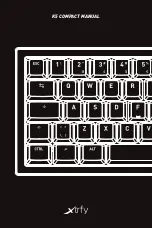
chaptEr5NorDElEctro4DrEfErENcE
| 11
Master level knob
.
This .control .sets .the .overall .output .level .of .
the .Electro .4D, .at .the .line .and .the .headphone .
outputs . .This .is .not .a .programmable .control . .If .
you .want .to .set .an .output .level .for .a .particular .
program, .this .can .be .achieved .with .the .Gain .
control .
Organ section
The .Organ .section .in .the .Nord .Electro .4D .features .emulations .of .three .
classic .organ .models; .a .B3, .a .Vox .Continental .II .(Vx .model) .and .a .
Farfisa .Compact .DeLuxe .(Farf .model) .
Organ Model button
You .select .which .organ .model .to .use, .with .the .
Organ .Model .button .
The B3 model
This .model .is .a .digital .simulation .of .the .classic .
mechanical .tone .wheel .organ . .This .simulation .utilizes .innovative .and .
advanced .methods .to .capture .every .nuance .of .the .original .sound, .for .
example:
• .An .extremely .accurate .digital .model .of .the .original .chorus .and .vibrato .
scanner .
• .Modeling .of .the .individual .random .contact .bounces .for .each .harmonic .
• .Modeling .of .the .unique .frequency .characteristics .of .the .built-in .pre-
amplifier .which .forms .the .“body” .of .the .sound .
• .Simulation .of .the .energy .robbing .in .the .tone .wheel .architecture .that .
creates .the .typical .“compressed” .sound .
• .Authentic .tuning .of .the .tone .wheels .according .to .the .original .design .
• .Extremely .fast .keyboard .response . .
• .Full .polyphony . .
Each .drawbar .represents .a .partial .with .a .fixed .harmonic .interval .relating .
to .the .played .note . .Note .that .the .5 .1/3 .drawbar .is .a .5th .above .the .
fundamental .harmonic .although, .in .most .situations .it .is .perceived .as .
sounding .below .the .fundamental .harmonic .
M
DoMnotMforgetMtoMtryMoutMtheMfourMtonewheelMmodesMthatMareMavail-
ableMinMtheMB3Mmenu,MseeMpageM19.MTheseMwillMdramaticallyMchangeM
theMsoundMofMtheMB3MmodelMfromMsqueakyMcleanMtoMaMbattered,MoldM
workMhorse.
The VX model
The .original .instrument .is .probably .the .most .famous .of .all .the .tran-
sistor-based .combo .organs .that .emerged .in .the .early .60’s . .Transistor .
technology .made .it .possible .to .manufacture .much .more .compact .and .
portable .organ .instruments . .Compared .to .the .mighty .sound .of .tone-
wheel .organs, .transistor .organs .generally .sounded .reedier .and .weaker, .
but .this .one .had .a .distinctive, .timeless .sound .and .is .recreated .faithfully .
in .the .Nord .Electro .4D .
The .labels .used .for .the .VX .model .drawbars .are .printed .on .the .row .
directly .above .the .drawbars . .The .drawbars .on .the .Electro .4D’s .VX .
emulation .control .the .level .of .each .available .partial, .in .the .same .fashion .
as .on .a .dual .manual .original .Continental . .The .upper .manual .uses .the .
16, .8, .4, .II .and .III .registers .and .the .lower .manual .uses .the .8, .4, .2 .and .IV .
registers . .Each .register .represents .a .fixed .harmonic .interval, .or .groups .
of .intervals .(the .II, .III .and .IV) .in .a .relationship .to .the .played .note . .
The .two .rightmost .drawbars .control .the .sum .of .all .partials .in .the .form .
of .a .filtered, .soft .and .dark .sounding .signal .(the .sine .icon), .and .an .un-
filtered .signal .with .a .bright .and .intense .sound .(the .triangular .icon) . .
M
M
IfMtheseMdrawbarsMareMbothMfullyMsetMtoMtheMlowestMlevel,MtheMorganM
willMproduceMnoMsound.
The Farf model
This .typical .“buzzy” .sound .of .this .vintage .instrument .is .one .of .the .most .
distinct .and .easily .recognizable .organ .sounds .ever .created, .yet .it .is .ac-
tually .possible .to .get .quite .a .wide .range .of .sounds .out .of .the .instrument . .
The .labels .used .for .the .Farf .model .drawbars .are .printed .on .the .upper .
row .above .the .drawbars . .
The .drawbars .act .as .on/off .switches, .or .“Register .selectors” .when .the .
Farf .model .is .selected . .
5
Nord Electro 4D Reference












































